Tactile paving
Originally developed in Japan, tactile paving is now used around the world as a means of conveying important safety information to the visually impaired about their immediate environment.
Most tactile paving is in the form of concrete flags that conform to the manufacturing standards set out in BS EN 1339.
Surface-mounted tiles that are stuck to the pavement are an alternative.
There are six standard patterns.
• Blister paving denotes a road crossing place with a dropped kerb.
• Offset blister paving indicates a platform edge in an off-street location, such as a railway station.
• Lozenge paving is used to indicate a platform edge in an on-street location, such as a tram stop.
• Hazard warning paving denotes a hazard, such as the top of a flight of stairs.
• Cycleway paving indicates the beginning of a shared cycle / pedestrian route, and indicates which lane each should use.
• Directional guidance paving indicates the safest direction of travel.
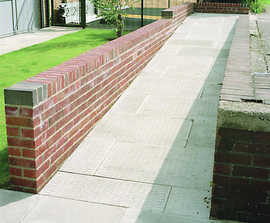 Barface concrete tactile pavingBarface concrete tactile paving provides an excellent non-slip surface. It is ideal for use on areas such as steep inclines and access ramps....Marshalls
Barface concrete tactile pavingBarface concrete tactile paving provides an excellent non-slip surface. It is ideal for use on areas such as steep inclines and access ramps....Marshalls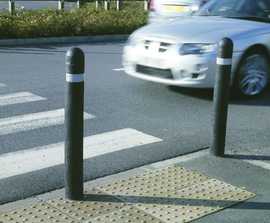 Blister concrete tactile pavingBlister is a concrete tactile paving used to identify the location of a drop kerb and an appropriate place to cross. The Blister surface is easy for the blind to feel underfoot, and the colours can be detected by the visually impaired. Red units are for use at controlled crossing points. Buff units are for use at uncontrolled crossing points...Marshalls
Blister concrete tactile pavingBlister is a concrete tactile paving used to identify the location of a drop kerb and an appropriate place to cross. The Blister surface is easy for the blind to feel underfoot, and the colours can be detected by the visually impaired. Red units are for use at controlled crossing points. Buff units are for use at uncontrolled crossing points...Marshalls Hazard warning tactile pavingHazard Warning is a concrete tactile paving sometimes referred to as corduroy paving. It is designed to warn visually impaired people of a hazard - such as stairs, level crossings and intersections of shared cycle/pedestrian routes - and lets them know they need to proceed with caution....Marshalls
Hazard warning tactile pavingHazard Warning is a concrete tactile paving sometimes referred to as corduroy paving. It is designed to warn visually impaired people of a hazard - such as stairs, level crossings and intersections of shared cycle/pedestrian routes - and lets them know they need to proceed with caution....Marshalls Tactile paving studsTactile paving studs create a textured surfaces underfoot and are found on many crossings, footpaths, stairs and train station platforms to assist blind and visually-impaired pedestrians by being detectable by long cane or underfoot. Fully compliant to the building regulations and Disability Discrimination Act (DDA). Height - 35mm; diameter - 25mm...Street Furnishings
Tactile paving studsTactile paving studs create a textured surfaces underfoot and are found on many crossings, footpaths, stairs and train station platforms to assist blind and visually-impaired pedestrians by being detectable by long cane or underfoot. Fully compliant to the building regulations and Disability Discrimination Act (DDA). Height - 35mm; diameter - 25mm...Street Furnishings ASF tactile paving studsASF produces tactile paving studs in stainless steel or brass: 25mm diameter; 5mm head depth; 32mm stem depth; cross hatched top....Architectural Street Furnishings
ASF tactile paving studsASF produces tactile paving studs in stainless steel or brass: 25mm diameter; 5mm head depth; 32mm stem depth; cross hatched top....Architectural Street Furnishings Moselden Yorkstone tactile pavingMoselden Yorkstone is a hard and durable buff to light grey sandstone that brings a unique crescent shaped banded appearance in many pieces. With high slip resistance Moselden Yorkstone is highly suitable for both pedestrian and trafficked applications. Produced to the highest standards, both the Moselden quarry and the manufacturing works are...Marshalls
Moselden Yorkstone tactile pavingMoselden Yorkstone is a hard and durable buff to light grey sandstone that brings a unique crescent shaped banded appearance in many pieces. With high slip resistance Moselden Yorkstone is highly suitable for both pedestrian and trafficked applications. Produced to the highest standards, both the Moselden quarry and the manufacturing works are...Marshalls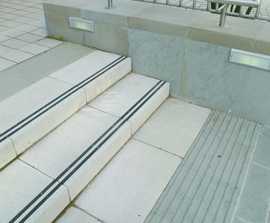 Scoutmoor Yorkstone tactile pavingMarshalls Yorkstone tactile paving has excellent non-slip properties. It is extremely durable and is used extensively in demanding applications. Scoutmoor is the strongest Yorkstone in the UK and is widely used throughout London because of its high strength and excellent slip resistance. Extremely durable, it is suitable for pedestrian and...Marshalls
Scoutmoor Yorkstone tactile pavingMarshalls Yorkstone tactile paving has excellent non-slip properties. It is extremely durable and is used extensively in demanding applications. Scoutmoor is the strongest Yorkstone in the UK and is widely used throughout London because of its high strength and excellent slip resistance. Extremely durable, it is suitable for pedestrian and...Marshalls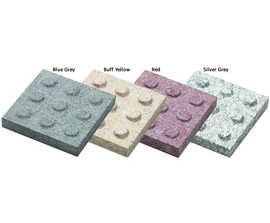 Blister Tactile granite pavingBlister tactile paving for pedestrian crossings in Blue Grey Granite, Buff Yellow Granite, Red Granite or Silver Grey Granite. Sandblasted top surface. 400x400x63mm....CED Stone Group
Blister Tactile granite pavingBlister tactile paving for pedestrian crossings in Blue Grey Granite, Buff Yellow Granite, Red Granite or Silver Grey Granite. Sandblasted top surface. 400x400x63mm....CED Stone Group Granite Corduroy Tactile PavingNatural stone corduroy paving in Black Basalt, Blue Grey Granite, Buff Yellow Granite or Silver Grey Granite to alert pedestrians of impending danger or a grade change. Sandblasted top surface with ’ribs’. 400mm x 400mm x 63mm....CED Stone Group
Granite Corduroy Tactile PavingNatural stone corduroy paving in Black Basalt, Blue Grey Granite, Buff Yellow Granite or Silver Grey Granite to alert pedestrians of impending danger or a grade change. Sandblasted top surface with ’ribs’. 400mm x 400mm x 63mm....CED Stone Group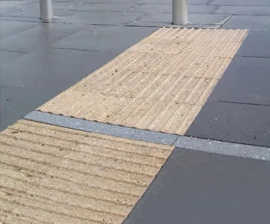 Granite corduroy tactile pavingPomery Natural Stone produces natural granite corduroy tactile paving in various thicknesses to suit adjacent paving. It allows for integrated natural stone schemes with provision for the partially sighted. Corduroy tactile paving is supplied in standard 400 x 400mm sizes in depths to suit adjacent paving or made to order. Colour options include...Pomery Natural Stone
Granite corduroy tactile pavingPomery Natural Stone produces natural granite corduroy tactile paving in various thicknesses to suit adjacent paving. It allows for integrated natural stone schemes with provision for the partially sighted. Corduroy tactile paving is supplied in standard 400 x 400mm sizes in depths to suit adjacent paving or made to order. Colour options include...Pomery Natural Stone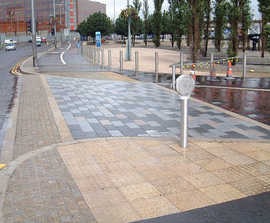 Granite blister tactile pavingPomery Natural Stone supplies granite blister tactile paving for controlled and uncontrolled crossings, produced in thicknesses to suit adjacent paving. For controlled pedestrian crossings, red tactile paving must be used. For uncontrolled pedestrian crossings, buff tactile paving is usually used, but any colour apart from red may be specified...Pomery Natural Stone
Granite blister tactile pavingPomery Natural Stone supplies granite blister tactile paving for controlled and uncontrolled crossings, produced in thicknesses to suit adjacent paving. For controlled pedestrian crossings, red tactile paving must be used. For uncontrolled pedestrian crossings, buff tactile paving is usually used, but any colour apart from red may be specified...Pomery Natural Stone Red blister tactile granite pavingPomery Natural Stone red granite blister tactile paving is supplied for controlled crossings, produced in thicknesses to suit adjacent paving. Blister tactile paving standard plan size is 400x400mm. Thickness to suit adjacent paving. Pomery Natural Stone materials are made to order or supplied from stock depots in the North West and South East...Pomery Natural Stone
Red blister tactile granite pavingPomery Natural Stone red granite blister tactile paving is supplied for controlled crossings, produced in thicknesses to suit adjacent paving. Blister tactile paving standard plan size is 400x400mm. Thickness to suit adjacent paving. Pomery Natural Stone materials are made to order or supplied from stock depots in the North West and South East...Pomery Natural Stone Custom large-format tactile concrete paving, Leuven (B)Tactile slabs in a special custom large format were required for a high-speed train station platform in Leuven, Belgium. Urbastyle manufactured large-format (200x90cm) concrete paving in white with tactile studs and a smooth 'visia' finish. They were manufactured to meet high standards in terms of design, structure and finish. These slabs help to...URBASTYLE®
Custom large-format tactile concrete paving, Leuven (B)Tactile slabs in a special custom large format were required for a high-speed train station platform in Leuven, Belgium. Urbastyle manufactured large-format (200x90cm) concrete paving in white with tactile studs and a smooth 'visia' finish. They were manufactured to meet high standards in terms of design, structure and finish. These slabs help to...URBASTYLE®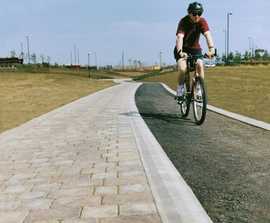 Cycleway Demarcation Block - profiled edging unitMarshalls Cycleway Demarcation Paving is used to alert pedestrians, including the visually impaired, to the presence of a cycleway. The solid concrete unit has a profiled surface designed to indicate the beginning or end of shared cycle/pedestrian routes that are not separated by different levels. It is also used as a central delineation strip...Marshalls
Cycleway Demarcation Block - profiled edging unitMarshalls Cycleway Demarcation Paving is used to alert pedestrians, including the visually impaired, to the presence of a cycleway. The solid concrete unit has a profiled surface designed to indicate the beginning or end of shared cycle/pedestrian routes that are not separated by different levels. It is also used as a central delineation strip...Marshalls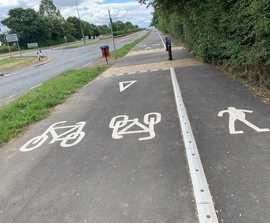 Raised Line DelineatorThe Raised Line Delineator is a tactile surface used in conjunction with a segregated shared cycle track/footway and is to advise visually impaired people of the correct side to enter. The delineator is normally installed along the length of the route dividing the pedestrian from the cyclist side and is compliant with the requirement set out...Rediweld Traffic Products
Raised Line DelineatorThe Raised Line Delineator is a tactile surface used in conjunction with a segregated shared cycle track/footway and is to advise visually impaired people of the correct side to enter. The delineator is normally installed along the length of the route dividing the pedestrian from the cyclist side and is compliant with the requirement set out...Rediweld Traffic Products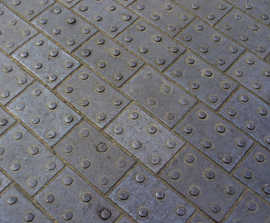 Tactile clay blister paversTactile pavers are designed to provide visually impaired pedestrians with an easily detectable indicator underfoot. Blister pattern pavers conform to the Department of Transport Disability Unit circular, Jan 1991 - The use of dropped kerbs and tactile surfaces at pedestrian crossing points, and are designed PB classification: tactile Blister...Ketley Brick Company
Tactile clay blister paversTactile pavers are designed to provide visually impaired pedestrians with an easily detectable indicator underfoot. Blister pattern pavers conform to the Department of Transport Disability Unit circular, Jan 1991 - The use of dropped kerbs and tactile surfaces at pedestrian crossing points, and are designed PB classification: tactile Blister...Ketley Brick Company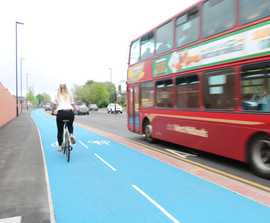 Colour cycle route surfacing improves connectivityNatraTex Colour® blue surfacing has been used to create safe cycling routes as part of Birmingham City Council's major highway improvements around the Selly Oak Triangle on the city's primary road network, with the key aim of improving connectivity...NatraTex
Colour cycle route surfacing improves connectivityNatraTex Colour® blue surfacing has been used to create safe cycling routes as part of Birmingham City Council's major highway improvements around the Selly Oak Triangle on the city's primary road network, with the key aim of improving connectivity...NatraTex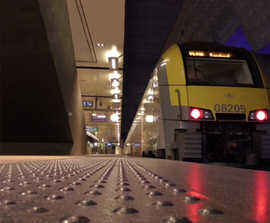 Architectural concrete platform edges for train stationUrbastyle's architectural concrete platform edges with ground and acid-etched finish were installed in a new tunnel built beneath Antwerpen-Centraal railway station in Belgium. The platforms were bordered with L-shaped edges. The architect opted for an anthracite colour, which contrasts with the adjacent light grey tiles. The surface of the...URBASTYLE®
Architectural concrete platform edges for train stationUrbastyle's architectural concrete platform edges with ground and acid-etched finish were installed in a new tunnel built beneath Antwerpen-Centraal railway station in Belgium. The platforms were bordered with L-shaped edges. The architect opted for an anthracite colour, which contrasts with the adjacent light grey tiles. The surface of the...URBASTYLE® Scoutmoor Yorkstone pavingScoutmoor Yorkstone paving is widely used in cities and towns throughout the UK because of its high strength and excellent slip resistance. Extremely durable, it is suitable for pedestrian and trafficked areas. It is a warm hard wearing stone which has a proven history on high use schemes such as Trafalgar Square. Scoutmoor is blue grey to brown...Marshalls
Scoutmoor Yorkstone pavingScoutmoor Yorkstone paving is widely used in cities and towns throughout the UK because of its high strength and excellent slip resistance. Extremely durable, it is suitable for pedestrian and trafficked areas. It is a warm hard wearing stone which has a proven history on high use schemes such as Trafalgar Square. Scoutmoor is blue grey to brown...Marshalls Ascella - Portuguese granite paving, kerbs and settsAscella is a pale grey / brown Portuguese granite available in a flamed, blasted, or honed finishes. It can be used as paving, tactile paving, setts, kerbs, steps, street furniture, water management or other bespoke specialised masonry items such as veneers for planters or furniture...Marshalls
Ascella - Portuguese granite paving, kerbs and settsAscella is a pale grey / brown Portuguese granite available in a flamed, blasted, or honed finishes. It can be used as paving, tactile paving, setts, kerbs, steps, street furniture, water management or other bespoke specialised masonry items such as veneers for planters or furniture...Marshalls Mixed grey granite commercial pavingPomery Natural Stone supplies granite paving in a colours ranging from silver grey to black for public realm and commercial paving schemes. Granite paving can be supplied in a wide range of sizes, usually in fixed widths and random lengths in thicknesses to suit the intended loading. Fully dimensioned granite paving can also be made to order...Pomery Natural Stone
Mixed grey granite commercial pavingPomery Natural Stone supplies granite paving in a colours ranging from silver grey to black for public realm and commercial paving schemes. Granite paving can be supplied in a wide range of sizes, usually in fixed widths and random lengths in thicknesses to suit the intended loading. Fully dimensioned granite paving can also be made to order...Pomery Natural Stone Imperial Edging StoneEdging stones provide a complete finishing touch for driveways, paths, lawn perimeters, patios and borders. Essential for preventing the escape of the laying course material from under paving and helps to create a tidy, finished look. Because of their strength and durability, Granite and Basalt are ideal materials for long-lasting borders and...CED Stone Group
Imperial Edging StoneEdging stones provide a complete finishing touch for driveways, paths, lawn perimeters, patios and borders. Essential for preventing the escape of the laying course material from under paving and helps to create a tidy, finished look. Because of their strength and durability, Granite and Basalt are ideal materials for long-lasting borders and...CED Stone Group Scoutmoor Yorkstone kerbsScoutmoor Yorkstone kerbs are widely used in cities and towns throughout the UK because of their high strength and excellent slip resistance. Suitable for pedestrian and trafficked areas...Marshalls
Scoutmoor Yorkstone kerbsScoutmoor Yorkstone kerbs are widely used in cities and towns throughout the UK because of their high strength and excellent slip resistance. Suitable for pedestrian and trafficked areas...Marshalls Callisto - silver grey granite pavingCallisto silver granite paving is used in vehicular trafficked and pedestrian areas due to its non-slip, non-skid qualities. Callisto Granite is available for complementary products including setts, kerbs, tactile, steps, water management, street furniture or other bespoke specialised masonry items such as veneers for planters or furniture: silver...Marshalls
Callisto - silver grey granite pavingCallisto silver granite paving is used in vehicular trafficked and pedestrian areas due to its non-slip, non-skid qualities. Callisto Granite is available for complementary products including setts, kerbs, tactile, steps, water management, street furniture or other bespoke specialised masonry items such as veneers for planters or furniture: silver...Marshalls